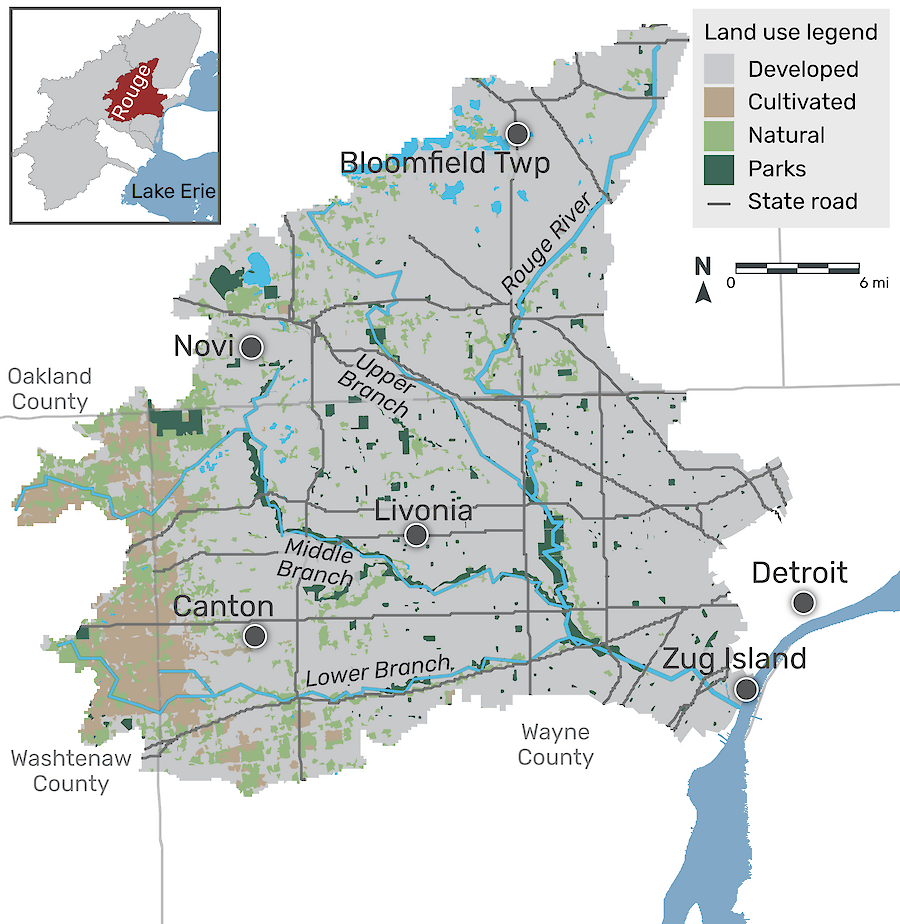 The Rouge River watershed is part of the Great Lakes Basin, one of the largest freshwater ecosystems in the world. It is the most urbanized watershed in Michigan, home to 1.35 million people in Oakland, Washtenaw, and Wayne counties. Historically, this area was inhabited by the three Anishinaabe nations: the Ojibwe, Ottawa, and Potawatomi. The river has four major branches that cover 127 miles. Most of the watershed is located within a former lake bed, with glacial moraines forming the headwaters of the Main, Upper, and Middle branches. The headwaters of all four branches contain most of the remaining natural land and the healthiest portions of the watershed. Johnson Creek, a cold water tributary to the Middle branch, is home to sensitive aquatic insects, brown trout, and redside dace, which is endangered in Michigan. Tributaries and upper portions of the Lower Branch are protected by nature preserves and farmland and contain rare insects and fish. The last undeveloped areas of the Middle and Lower headwaters are undergoing massive land development. These changes will greatly impact the river.
The Rouge River watershed is part of the Great Lakes Basin, one of the largest freshwater ecosystems in the world. It is the most urbanized watershed in Michigan, home to 1.35 million people in Oakland, Washtenaw, and Wayne counties. Historically, this area was inhabited by the three Anishinaabe nations: the Ojibwe, Ottawa, and Potawatomi. The river has four major branches that cover 127 miles. Most of the watershed is located within a former lake bed, with glacial moraines forming the headwaters of the Main, Upper, and Middle branches. The headwaters of all four branches contain most of the remaining natural land and the healthiest portions of the watershed. Johnson Creek, a cold water tributary to the Middle branch, is home to sensitive aquatic insects, brown trout, and redside dace, which is endangered in Michigan. Tributaries and upper portions of the Lower Branch are protected by nature preserves and farmland and contain rare insects and fish. The last undeveloped areas of the Middle and Lower headwaters are undergoing massive land development. These changes will greatly impact the river.
The Upper Branch is the steepest (21 feet/mile) in its major tributaries and is home to many sensitive fish like the redside dace. The Lower Branch has the lowest gradient (10.9 ft/mi) and low baseflow; dissolved oxygen levels often dropped to zero in the summer until the Ypsilanti Wastewater Treatment Plant began discharging treated effluent into the Lower Branch in 1996. The increased flow (25 million gallons per day) led to better dissolved oxygen levels and a subsequent growing fish population. This allowed for the development of a water trail for paddlers to enjoy the river.
The lower portion of the Rouge River, known as the Main Stem, has long been treated as a working river and has suffered pollution over time. A shortcut channel created Zug Island at the mouth of the river before the beginning of the 19th century; industrial development continued into the twentieth century with the creation of the turning basin or the Ford Rouge Complex. In 1969, the Rouge River ran so thick with oil it caught on fire. In the 1970s, six miles of the river were straightened and encased in concrete to prevent flooding. Combined sewers, constructed as the area developed, reached capacity quickly, and sewage overflows into the river became common occurrences. Stormwater runoff is now responsible for over 70% of the river’s pollution problems.
The Clean Water Act and public outcry led to the designation of the Rouge River as an Area of Concern in 1987, with nine beneficial use impairments, and the formation of Friends of the Rouge in 1986. The Rouge River National Wet Weather Demonstration Project provided much-needed funds to clean up the river. The Great Lakes Restoration Initiative in 2014 has provided further funding.
Friends of the Rouge has been working for 37 years to raise awareness about the state of the Rouge River and to restore, protect, and enhance the watershed through stewardship, education, and collaboration. They work in partnership with many entities in the watershed, including the Alliance of Rouge Communities and the Rouge River Advisory Council. Collaboration has been the historical key to success, and will continue to drive restoration efforts in the Rouge River’s path to recovery.
